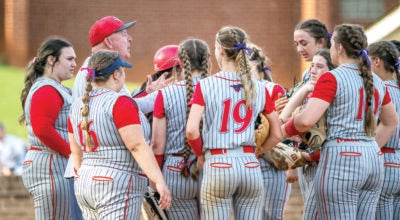Baseball: Waving goodbye to Yankee Stadium today
Published 12:00 am Saturday, September 20, 2008
By Ronald Blum
Associated PressNEW YORK ó This evening, they will walk off America’s most famous field for the final time.
No more sunny days spent watching the pinstripes run out across the same ground once patrolled by Ruth and Gehrig, DiMaggio and Mantle.
No more October afternoons with shadows creeping across the grass.
No more glorious nights with balls soaring into the upper deck as the old place shimmies from leaping, boisterous fans, their roar carrying out to the subway tracks on River Avenue and beyond.
It was an edifice built to symbolize American power, a place meant to hold the same place in New York’s imagination as the Colosseum does in Rome’s.
And now, 851/2 years after it was opened, Yankee Stadium is about to close.
“I’m going to miss it all,” Yogi Berra said wistfully.
So much of baseball’s history has occurred on this five-sided patch of land near the Harlem River: Of the 601 World Series games, 100 have been played here. Eleven no-hitters have been pitched here, including three of Major League Baseball’s 17 perfect games.
There are the monuments and the short porch. Before a renovation that added amenities and subtracted ambiance, there was the copper frieze and Death Valley. The new Yankee Stadium, a $1.3 billion palace rising just across 161st Street, may have the latest in comforts, food and amenities, but it will never replace the history of the original.
Ask Reggie Jackson for a Yankee Stadium memory, and he recalls his first. The date: April 15, 1968.
“What I remember most was seeing Mickey Mantle,” he said. “I played against Mickey Mantle, man. I looked down at his shoes. He had No. 7 on them. He stopped and let me go past him. He knew my name.”
Retracing the path of Hall of Famers often runs through players’ minds ó especially these days ó as they walk up the five dugout steps, crane their necks up at the vast crowd, then sprint onto the field.
“Just being able to run out on the grass where all the great players once did ó that definitely will be missed,” Yanks outfielder Johnny Damon said. “Yeah, I kind of enjoyed being able to play on the same field that Joe DiMaggio and Mickey Mantle and Babe Ruth did, and hit the ball into the upper deck just like those guys.”
Built for $2.5 million, America’s first three-deck sports showcase rose over 284 working days in 1922 and 1923 ó before there was an Empire State Building. They called it “The Yankee Stadium” back then, the article importing its grandeur during a gilded age.
Constructed on land purchased from the William Waldorf Astor estate for $675,000, it was right across the river from the team’s former home, the Polo Grounds, which the Yankees rented from their National League rival, the New York Giants. Cromwell Avenue had to be eliminated for the ballpark to be built.
Some of the Osborn Engineering Co.’s original design still stands. One afternoon during the final homestand, Yankees manager Joe Girardi walked down the long corridor toward right field and was able to point out the difference between an original wall, constructed with railroad ties, and one from the 1970s reconstruction, where the outlines of each block are visible.
What sticks with some about the stadium is the sound, a wall of primal noise unleashed by the fans.
“It’s incredible that stadium, just the power of it,” said former manager Joe Torre. “You can feel the heartbeat of the people in the stands, especially when you’re playing the Red Sox or the Mets but especially the Red Sox. And then, of course, postseason play.”
Cheers began the very first day, when Ruth hit a three-run homer in a 4-1 win over ó who else? ó Boston, on April 18, 1923.
There was that Fourth of July when Gehrig proclaimed himself “the luckiest man on the face of the earth,” and the two days in 1948 when 77,000 mourners walked past Ruth’s open casket.
There was Roger Maris’ 61st homer in 1961, the time Mantle hit the frieze ó nearly clearing the ballpark ó against Bill Fischer in 1963 and the night Chris Chambliss homered to end the AL championship series in 1976, when it seemed every single fan sprinted onto the field. There was Jackson’s three-homer night in Game 6 the following year, giving owner George Steinbrenner the first of his six World Series titles.
To commemorate the past, Girardi has a pair of home plates saved in his house ó from Dwight Gooden’s no-hitter and Cone’s perfect game. Torre called Lou Cucuzza Jr., the visiting clubhouse manager, and asked him to save a pair of seats from the stands. Cucuzza himself had players on visiting teams sign a door that he had removed from his office and will take to the new stadium.
Derek Jeter says he plans to steal something ó he won’t say what.
“I’ll miss it. It’s too bad that they’re going to tear it down,” said Bob Feller, who pitched a no-hitter here for Cleveland in 1946.
But this sorry season will end without another World Series, not even a playoff appearance. It’s a melancholy coda to Yankee Stadium’s symphony of success.
That makes saying goodbye all that much tougher when Frank Sinatra’s recording of “New York, New York” is played after a game for the final time.
The last home run will have been hit, the last game won and lost.
“I will definitely be sad,” Jeter said. “It doesn’t get better than Yankee Stadium.”





